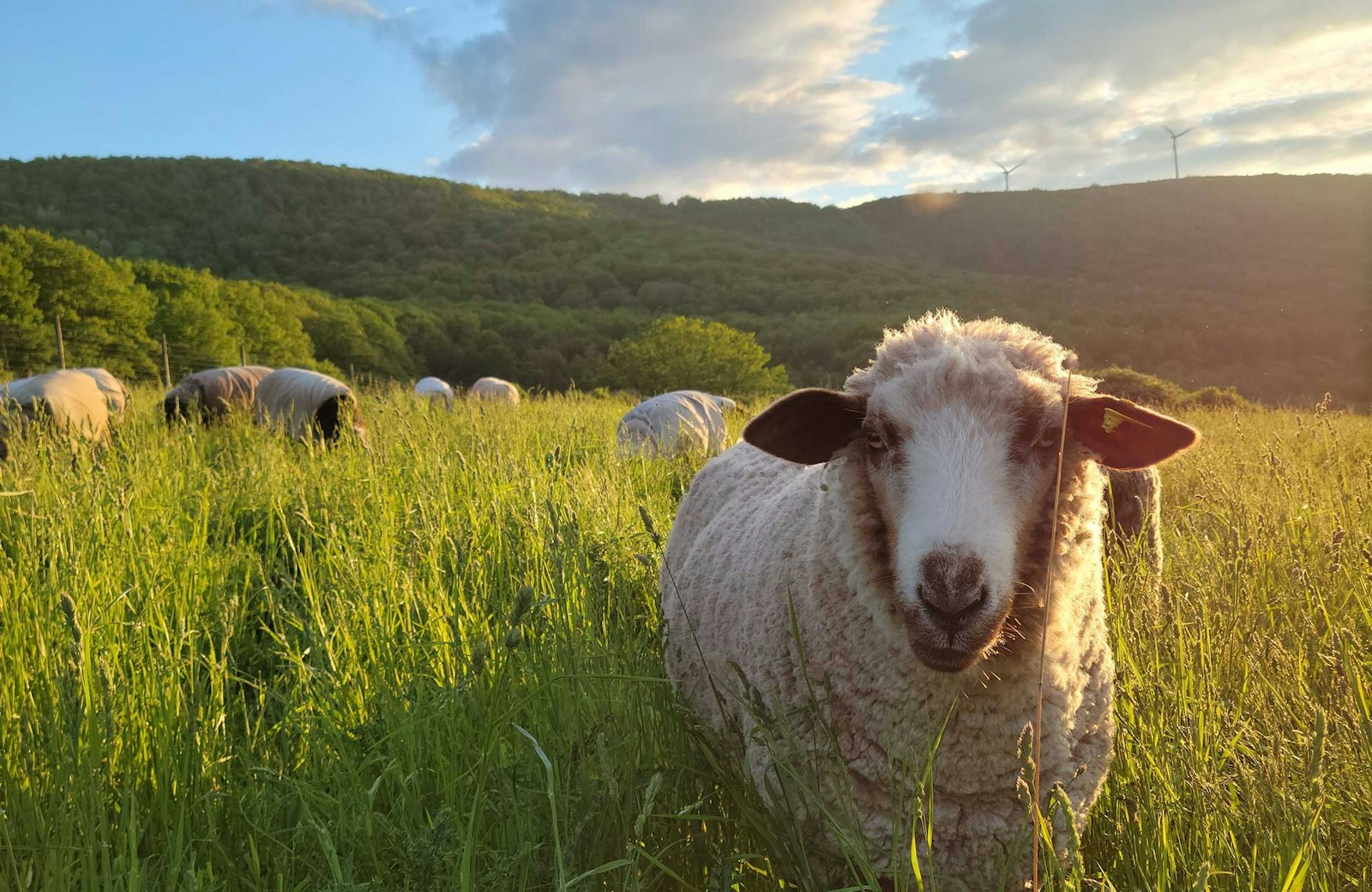Contents
As knitters, we don’t always seek to understand each and every nuance of a sheep breed’s characteristics in our yarn selection, but we know what we’d like in an ultimate skein of yarn. For many, it would be soft enough to wear next to the skin and knit up equally well as a squishy stockinette or garter stitch, while still providing good stitch definition in a cabled knit. This would be a farm yarn that knits luxuriously without losing its slightly rustic roots, and we’d want the sheep who graced us with this wool to be well loved and cared for sustainably, with open pastures and natural, chemical-free green spaces.
Enter Bohlayer’s Orchards and its fifth-generation shepherds, Heather and David Loomis. Thanks to Heather’s direction, the aforementioned yarn already exists in a highly sought-after, small-batch farm yarn from the rare-breed Romeldale CVM sheep living their best lives on the Loomis’s Pennsylvania property.
 David Loomis checks on the sheep.
David Loomis checks on the sheep.
History of Romeldale CVM
Romeldale CVM is a critically endangered US breed, as categorized by The Livestock Conservancy. Its genetic makeup and meticulous breeding history makes this is a versatile, bouncy, adaptable wool. Breed standard is a fine 20–25 micron, 3–6-inch staple length.
The Romeldale breed was developed in 1915 as a cross between New Zealand Romney and American Rambouillet, with the goal of producing both a good meat source and a longer-stapled, still fine and elastic wool from sheep that could thrive in the range of seasonal climate changes in Northern California. For many years, Pendleton Mills purchased large amounts of this soft-yet-durable wool, which was a bright white color that could be easily dyed any color. These all-white flocks were selectively bred for improvement and consistent quality over generations.
Occasionally, natural color lambs would be born, and shepherd Glen Eidman took an interest in their beautiful, richly colored fleeces. By creating a flock of natural color Romeldale, Eidman soon developed a new breed: the California Variegated Mutant (CVM). Today, CVM may be born in an assortment of natural colors and/or with variegated markings, but the “badger face” is key.
Get a closer look! Click any image in the gallery below to open it in full-screen mode.
Bohlayer’s Orchards—From Fruit to Fleece
Bohlayer’s Orchards has been a self-sustaining farm and fruit orchard since 1876. It’s where David grew up, as did generations of relatives before him. He and Heather volunteered to take over the property and business in 2005 as something of a moral obligation. “We didn’t want to be the generation that had better things to do,” says Heather, but environmental changes had other plans for the couple.
After a year-over-year loss of fruit crops culminated in a total crop loss in 2012, Heather came up with a new game plan to sustain the farm, banking on a small flock of Romeldale CVM to help her do it. First, she sold the fleeces and then roving to eager handspinners (and still does). Then in 2019, Bohlayer’s partnered with Green Mountain Spinnery to card and spin the perfect knitting yarn, focusing on DK weight since it’s so adaptable on its own or held double.
 Skeins of DK yarn in natural colors.
Skeins of DK yarn in natural colors.
A Little TLC Goes a Long Way
Each year’s offering of very small-batch yarns is impacted by ever-changing soil and grass—and, therefore, mineral intake. Heather does as much as possible to mitigate health concerns by feeding the sheep an entirely chemical-free, all-natural diet. In addition to grazing in open pasture for up to eight months of the year, the flock is fortified with sea kelp and other minerals. Antibiotics are limited. Just as important, she says, is the stress-free, predictable life these sheep live. Heather believes this makes the difference in her yarns.
Customers must agree. Bohlayer’s Orchards drops its new yarns each September, both in their online shop and at select fall markets. Some years, the yarn sells out before the fall festival circuit ends.
The natural colors change annually, impacted by ecological factors and the year’s lambing and shearing results. The 2025 lineup contains five different natural colors, including cream, moorit, black, and both light and darker grays. Each skein is 4 oz and 365–370 yards. There are only 100 skeins available in each colorway.
What’s It Like to Knit With?
According to Heather, the yarns are soft and smooth moving through the hands, with the slightest grip on the needle. Bohlayer’s customers comment that it creates beautiful stitch definition and is lovely in cable knits. “When knitted in stockinette, you get the chance to see a gentle texture variation, which always makes me think of the sheep the wool is from. And the loftiness of the wool lends itself to cozy garments with a slight structure and great memory, so you never have a garment that gets stretched out of shape,” Heather says.
 Clockwise from top left: Parasol Tee by Heidi Kirrmaier (knitted in DK weight), Sophie Scarf by PetiteKnit (DK), and Alpine Bloom Hat by Caitlin Hunter (knitted in DK weight); WIP Old Fashioned by Maxim Cyr (worsted weight); Timbo Vest by Gabriella Calderini (two different colors of DK held together); Nanook Cardi by Heidi Kirrmaier (worsted); and Autumn Vibes Shawl by Lucia Ruiz de Aguirre (DK).
Clockwise from top left: Parasol Tee by Heidi Kirrmaier (knitted in DK weight), Sophie Scarf by PetiteKnit (DK), and Alpine Bloom Hat by Caitlin Hunter (knitted in DK weight); WIP Old Fashioned by Maxim Cyr (worsted weight); Timbo Vest by Gabriella Calderini (two different colors of DK held together); Nanook Cardi by Heidi Kirrmaier (worsted); and Autumn Vibes Shawl by Lucia Ruiz de Aguirre (DK).
If you’re interested in knitting with the 2025 release, don’t wait. Sign up for the farm’s newsletter on the Bohlayer’s Orchards website, and be sure to purchase the yardage you need, as once these yarns sell out, they’re gone for good.





